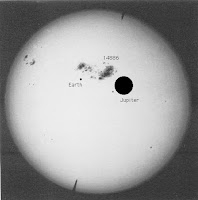As we move through solar maximum in the solar north we can start comparing Solar Cycle 24 with other data. Here is a comparison of the active region 11476 in an HMI image from May 11, 2012 with the Earth (small dot) and Jupiter (big dot). AR 11476 covered about 1100 area units at its largest size. People claimed it was as big as Jupiter! We can see here that the dark core part of 11476 (called the umbra) was still quite small. Even though the entire sunspot was about half the size of Jupiter, it is mostly the dimmer penumbra.
Compare with the largest sunspot we have in a photograph, AR 14886 from April 7, 1947. We put the Earth and Jupiter disks in again and see that AR 14886 is larger (6000 units) than AR11476, still a little smaller than Jupiter (which is 10,000 units), and the dark umbra appears to occupy a larger fraction of the sunspot. (Original picture is courtesy of the Carnegie Institution of Washington.)
One of the largest sunspot in Solar Cycle 23 was 10486, which caused the massive Halloween storms of 2003. It was 2600 units at its largest. The largest sunspots tend to occur after solar maximum and the larger sunspots tend to last longer as well. As we move through solar maximum in the northern hemisphere and look to the south to pick up the slack there should be plenty of sunspots to watch rotate by SDO.
CHECK IT OUT: SDO images are featured in the June issue of National Geographic!


